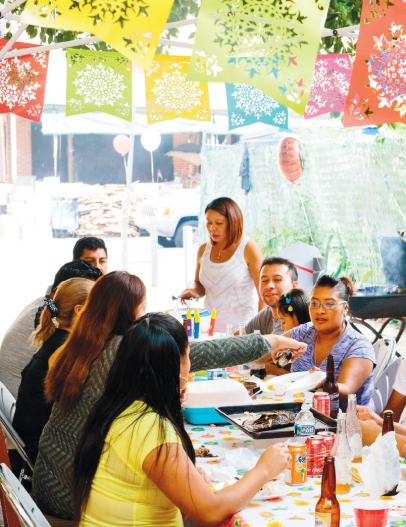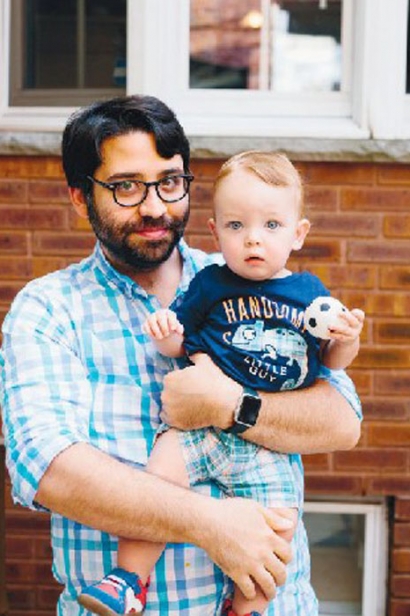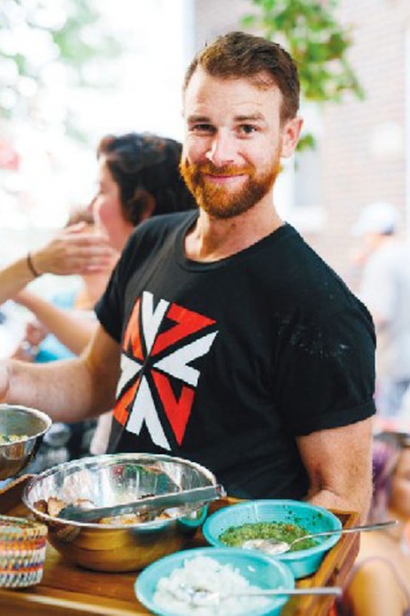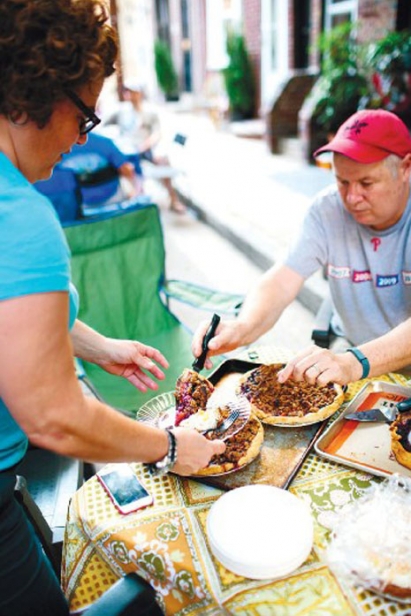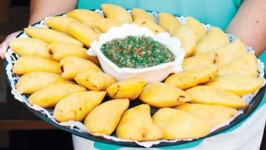KNOW YOUR NEIGHBORS
The League Street block party in Bella Vista brings a diverse community together
On a narrow, tree-lined street just off the Italian Market, more than 50 neighbors gathered outside their homes. At one end of the block, a cluster of kids juggled a soccer ball near a table strewn with bright orange Fanta cans. A band set up on the curb, led by an elderly man singing Puerto Rican ballads. The smell of charcoal and meat hung in the sticky, late summer air. It was Labor Day, and the residents of League Street sat at folding tables and perched on shaded front stoops, holding paper plates heavy with varied dishes like barbecued pork, mole enchiladas, spring rolls and berry pie.
It’s a familiar scene; block parties are an iconic marker of summer in Philadelphia. Often around holidays (the city only grants official permits during Memorial Day, Fourth of July and Labor Day weekends), residents in neighborhoods across the city plan to gather and share food. They spend an entire afternoon eating and relaxing with the people they live among, but might rarely connect with.
Though these parties are common throughout Philly, the one on League Street is a particularly longstanding tradition. Neighbors have been holding block parties here each summer for nearly 30 years.
The tradition has been sustained in part because people on this street are seriously into food. The nearby Italian Market draws both workers and food enthusiasts who recognize there’s no better place in the city to find culturally diverse fare. Many of them are professional or serious home cooks who love a chance to show off their specialties. At the Labor Day party last year, Larry Schnell, a butcher at Cannuli’s Meats, stood proudly in front of his slow cooker, assembling pulled pork sandwiches with homemade barbecue sauce—“If you can’t deal with the heat, don’t try it,” he warned. “It’s hot.”
DJ and dog walker Lindsay Maria walked the block with an assemble-your-own carnitas taco platter featuring fresh tortillas from Tortilleria San Roman. Robin Tama, who runs the tasting room at Flying Fish Brewing in Somerdale, New Jersey, sat before a platter of garlicky Argentinian chicken that she’d made with her husband. “We’re going to poach everyone else’s desserts,” she said, eyeing the crumb-topped pie on a nearby table.
The neighbors on this block have ensured that the block party thrives, even through drastic changes in neighborhood demographics. As immigrants from Vietnam, Korea, Puerto Rico and Mexico have moved into the historically Italian neighborhood, there’s been conflict: worker exploitation, harassment and general hostility. But food has been a point of connection for the diverse population that has settled in Bella Vista; it’s a part of culture that can be easily shared and appreciated.
The League Street block parties create an opportunity for that exchange, and it’s helped these neighbors break down cultural misconceptions and build relationships.
As any neighbor will tell you, the block has formed a special community—even a visitor can feel it. Colorful Christmas lights are strung above the street between second-story windows; potted herbs are assembled on front stoops and sidewalks; one neighbor, Claudia Archer, has a jar of spare keys for nearly every front door on the block just in case someone gets locked out.
Through the decades, these summer gatherings have laid the solid foundation on which this block has become home to its diverse residents. The people here don’t just coexist—they look out for one another like family.
It wasn’t always this way. The neighborhood camaraderie on League Street was initiated by one resident who experienced hostility when she moved in several decades ago.
At the party last summer, the founder of the League Street block party emerged from her row house holding a platter of empanadas. She set them on the table with a bright bowl of salsa de cilantro and watched proudly as neighbors, who’d been waiting for that moment, snatched up the golden half-moons.
Epifania Ortiz’s specialty has gained a serious reputation in the neighborhood since she started the block party in the early 1990s. She’s described by League Streeters as the matriarch of the block. She has a warm, easy smile and a habit of reaching out to touch your arm as she talks. A 40-year League Street resident, she’s welcomed many newcomers to the block. Like Bonnie Ehri and her husband Gabe, who she invited over for her husband’s birthday party the weekend the couple moved in.
“We were on the couch in the middle of family and friends, barely able to speak any Spanish, but we felt so welcome,” Bonnie remembers. “That’s the Ortiz family.”
Epifania, now in her mid-60s, moved to League Street in 1976 when the neighborhood was made up almost solely of Italian families. She, from Colombia, and her Puerto Rican husband were some of the first Latino residents on the block, and they weren’t exactly warmly welcomed.
“When I introduced myself, I saw their expressions,” Epifania says. She was entering a tight community of big Italian families who had lived in that neighborhood their entire lives and were resistant to change.
Epifania’s neighbor Phillip DiSipio remembers the old League Street—he was born on the block and still lives there today, 73 years later. His grandpa came here from Italy with 14 siblings and 12 kids; Phillip grew up surrounded by aunts, uncles, cousins and siblings.
When the Ortiz family moved in, “there was some dissention,” Phillip says. “It was mostly Italian and she was Spanish—there was prejudice.”
Ortiz’s daughter, Michelle, can recall the discomfort she felt in her younger years. “I remember a time early, as a child, when people looked at us as if they didn’t want us to be here,” Ortiz says. Some neighbors wouldn’t acknowledge or talk to them. And some were more aggressive, openly criticizing their work as they fixed up their new home.
“And they were only a generation or two from being immigrants themselves,” Michelle says. “We knew who on the block were the folks that were supportive of us and saw themselves and their own history in our experience.”
The DiSipios were one of the few families that welcomed the Ortiz family wholeheartedly. Phillips’s mother, Annie, grew close with Epifania. Phillip suspects because they had so much in common, especially when it came to their kitchens. “They were compassionate, they both loved cooking, loved children,” he says, “My mother even watched some of her kids.”
Through her kids, Epifania connected with another new neighbor, Theresa Mollinari. She had moved to the block from New York to take care of her Italian mother-in-law. Theresa’s kids were a few years older than Epifania’s, but they went to the same school and the women developed a friendship. When Epifania decided to host that first party on the block, it was Theresa that she asked to be her co-planner.
The two posted flyers announcing the party. They went door to door, recorded the number of people that would attend from each household, and collected money to offset costs. They hired a DJ, decorated the street with balloon bouquets, and bought beer and wine. “I remember my mom making huge batches of macaroni and potato salad and chicken,” Michelle says, “It would be a full week of nonstop cooking.” On party day, the two women set up tables and chairs and asked other neighbors to work the grill.
By Epifania’s design, it was first and foremost a party, with dancing, games, beer and plenty of food, but it was also her way of healing the tension in the neighborhood. She hoped to break down the prejudice she’d experienced when she first moved to the block, which lingered as Vietnamese and Mexican immigrants moved in through the subsequent decades.
For at least 20 years, “Italian Market” has been a misnomer for Ninth Street. Lupita’s Grocery, Tortilleria San Roman and Las Lomas Grocery and Bakery are nestled among Italian mainstays like Esposito’s, Claudio’s, and DiBruno’s. Vietnamese restaurants and markets run perpendicular to the market on Washington Ave.
Many of the immigrant families who settled around the market in recent years have faced the same challenges the Ortizes did in the late 1970s. Nhung Nguyen, a longtime League Street resident, remembers moving with her family from Vietnam in 1986. “After the situation in 1975—the Viet Cong—we couldn’t stay there,” Nguyen remembers.
“The first two months we were here I cried every day and every night, because I didn’t know anyone,” she says. She had left her community and culture and travelled for 8 months to start from scratch in a foreign, and sometimes hostile, environment.
Epifania remembers seeing Nhung around the neighborhood in that first year and made it a point to connect with her. Around that time, Claudia Archer had helped Epifania change the format of the party: rather than collecting money and cooking for the entire block, everyone would bring out their own dishes to share.
Nhung joined the block party and became the anchor of the east end, making heaps of spring rolls, fried rice and her specialty: barbecued beef short ribs. “Every block party we marinated like 30 pounds,” she says. “We just have five people, but me and my husband like to share, so we marinate a lot!”
One year her husband, a butcher at Esposito’s, bought a quarter of a lamb to cook for the block party. Nhung, who can’t stand the smell of the meat, didn’t want to cook it, so another neighbor offered to keep it in her fridge until the party.
“We got this other neighbor, Dana, to cook it, but his wife said, ‘Not in our house,’” Claudia remembers. “So other neighbors who had their house on the market offered up their kitchen.”
The lamb was in four different kitchens before being served at the block party. “That’s how this neighborhood works,” Robin says.
Marco’s Fish Market is one of the many businesses on Ninth Street that have changed from Italian to Mexican hands in the last two decades. Alma Romero and Marco Tlacopilco, who moved to Philadelphia from Puebla, Mexico, now own it.
Marcos was part of a word-of-mouth network that brought people from Puebla to Philadelphia, primarily to work in the food industry. But it wasn’t easy for Marcos; he worked 10-hour shifts without lunch and was cheated out of pay. When Alma moved to join him, she lived in a row home with 18 men, among beer cans and trash. “It was too much for me,” Alma says, who had dreamed of buying a home with a garden in Mexico.
Now they rent a small house on League Street and work at their fish market from 7am to 5pm every day except Monday. “I have four kids; I need to pay for my daughters to go to college,” Romero says. “This is my dream now.”
Romero and her family joined the League Street block party for the first time on Labor Day last year. They sat at a long table that stretched down the center of the block with bright flags hung from the perimeter of a mounted tent frame. Plates were loaded with spicy mole enchiladas, chiles rellenos, stewed black beans, fresh pipicha (a cilantro-like herb), salsa verde and salsa roja. Alma, wearing a brightpurple floral shirt and leather sandals, stood at the grill with tongs, tending to cheese-stuffed plantains and fried whole branzino. “I like this day,” she says. “Everybody’s out. I work too much, so I don’t see my neighbors so much.”
At the far end of the block, Epifania Ortiz walked down her front steps carrying a frosted strawberry shortcake. She wove through toddlers racing back and forth on a plastic car; through the cluster of young parents lounging on the curb with plates of banana crème trifle; past Larry’s pulled pork and homemade barbecue and to the Romero table, setting the cake in front of Alma’s brother-in-law, Rosalio.
It was his birthday, and neighbors gathered to eat cake and watch as kids waited in line to swing at a piñata. It’s the scene Ortiz hoped for back when she started the party in the 1990s: people getting to know one another as people, living together in a diverse and supportive community.
The diversity brings a richness of ideas, perspectives, traditions, and food culture that strengthens the League Street community. “I think what might have caused tension in the past is part of what makes League Street so great now,” says Bonnie, who was welcomed to the neighborhood by Epifania 13 years ago. “We still have that mix of incomes and demographics that makes a block really healthy.”
As the neighborhood continues to change, the League Streeters are intent on upholding the block-party tradition to welcome new neighbors into the community.
“That’s the purpose: have a good time and be with your neighbors, like a family,” Epifania says. “I believe your neighborhood is part of your family, because you never know when you’re going to need it.”


